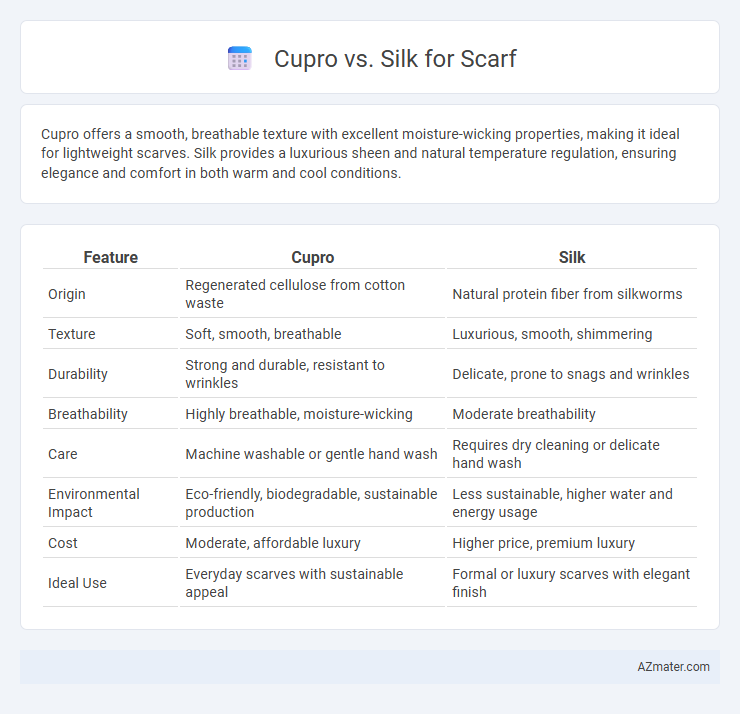Cupro offers a smooth, breathable texture with excellent moisture-wicking properties, making it ideal for lightweight scarves. Silk provides a luxurious sheen and natural temperature regulation, ensuring elegance and comfort in both warm and cool conditions.
Table of Comparison
| Feature | Cupro | Silk |
|---|---|---|
| Origin | Regenerated cellulose from cotton waste | Natural protein fiber from silkworms |
| Texture | Soft, smooth, breathable | Luxurious, smooth, shimmering |
| Durability | Strong and durable, resistant to wrinkles | Delicate, prone to snags and wrinkles |
| Breathability | Highly breathable, moisture-wicking | Moderate breathability |
| Care | Machine washable or gentle hand wash | Requires dry cleaning or delicate hand wash |
| Environmental Impact | Eco-friendly, biodegradable, sustainable production | Less sustainable, higher water and energy usage |
| Cost | Moderate, affordable luxury | Higher price, premium luxury |
| Ideal Use | Everyday scarves with sustainable appeal | Formal or luxury scarves with elegant finish |
What is Cupro?
Cupro is a regenerated cellulose fiber made from cotton linter, offering a smooth, silk-like texture that is breathable and hypoallergenic, making it ideal for scarves. It provides excellent moisture-wicking properties and drapes beautifully, similar to silk but with enhanced durability and easier care. Unlike traditional silk, Cupro is vegan-friendly and less prone to wrinkling, making it a popular alternative for luxury scarf fabrics.
What is Silk?
Silk is a natural protein fiber produced by silkworms, renowned for its smooth texture, strength, and luxurious sheen, making it a popular choice for scarves due to its breathability and comfort against the skin. Unlike Cupro, which is a regenerated cellulose fiber derived from cotton linter, silk offers superior temperature regulation and moisture-wicking properties, ideal for year-round wear. The natural origins and unique fiber structure of silk contribute to its high cost and delicate care requirements compared to more durable, easy-care Cupro fabrics.
Cupro vs Silk: Texture and Appearance
Cupro offers a smooth, lustrous texture similar to silk but with a slightly more matte finish, providing a subtle elegance in scarves. Silk boasts a natural sheen and a softer, more fluid drape, delivering a classic luxury feel with vibrant color richness. Both fabrics excel in lightweight comfort, yet cupro's breathable and hypoallergenic properties make it a practical alternative to traditional silk scarves.
Durability and Longevity
Cupro scarves offer exceptional durability due to their strong, fine fibers that resist pilling and maintain shape over time, making them ideal for frequent wear. Silk scarves, while luxurious and soft, are more delicate and prone to snags and deterioration with regular use or improper care. For long-lasting wear, cupro provides superior longevity and resilience compared to the more fragile silk fabric.
Breathability and Comfort
Cupro, a regenerated cellulose fiber derived from cotton linter, offers superior breathability due to its moisture-wicking properties, making it ideal for scarves worn in warm climates. Silk, a natural protein fiber, provides a smooth, luxurious feel and excellent thermal regulation but tends to retain heat slightly more than cupro, which can affect comfort in hotter conditions. When prioritizing breathability and comfort, cupro scarves often outperform silk by allowing better airflow and moisture evaporation, ensuring a cooler and more comfortable experience.
Sustainability and Environmental Impact
Cupro, a regenerated cellulose fiber derived from cotton linter, offers a more sustainable alternative to silk by utilizing cotton waste and employing a biodegradable process with lower water consumption and reduced chemical use. Silk production involves silkworm farming, which requires extensive water, land, and resources, often contributing to habitat disruption and higher greenhouse gas emissions. Choosing cupro scarves supports eco-friendly fashion through upcycling agricultural byproducts and minimizing environmental footprint compared to traditional silk.
Maintenance and Care Requirements
Cupro scarves require gentle hand washing with mild detergent and air drying to maintain their soft, silk-like texture, while avoiding direct sunlight to prevent fabric deterioration. Silk scarves demand even more delicate care, including cold water hand washing or dry cleaning to preserve their natural sheen and prevent fading or damage to the fibers. Both fabrics should be stored away from moisture and rough surfaces to prevent snagging and maintain longevity.
Price Comparison
Cupro scarves generally offer a more affordable price point compared to silk scarves, making them an attractive option for budget-conscious shoppers. Silk scarves, known for their luxurious texture and natural sheen, often command higher prices due to the cost of raw silk and intricate weaving processes. While silk prices vary based on quality and brand, cupro provides a cost-effective alternative without compromising on softness and drape.
Best Uses for Cupro and Silk Scarves
Cupro scarves excel in breathability and moisture-wicking, making them ideal for warm weather and sensitive skin due to their hypoallergenic properties. Silk scarves are best suited for formal occasions and cooler climates because of their natural sheen, insulating qualities, and luxurious texture. Both materials offer lightweight comfort, but cupro is preferred for casual, everyday wear, while silk adds elegance and sophistication to special events.
Which Material Should You Choose?
Cupro scarves offer a smooth, breathable texture derived from regenerated cotton fibers, making them an eco-friendly and hypoallergenic choice perfect for sensitive skin. Silk scarves provide a luxurious sheen and natural temperature regulation, ideal for those seeking elegance and moisture-wicking properties in their accessories. Choosing between Cupro and Silk depends on preferences for sustainability and softness versus lustrous appearance and traditional luxury.

Infographic: Cupro vs Silk for Scarf
 azmater.com
azmater.com